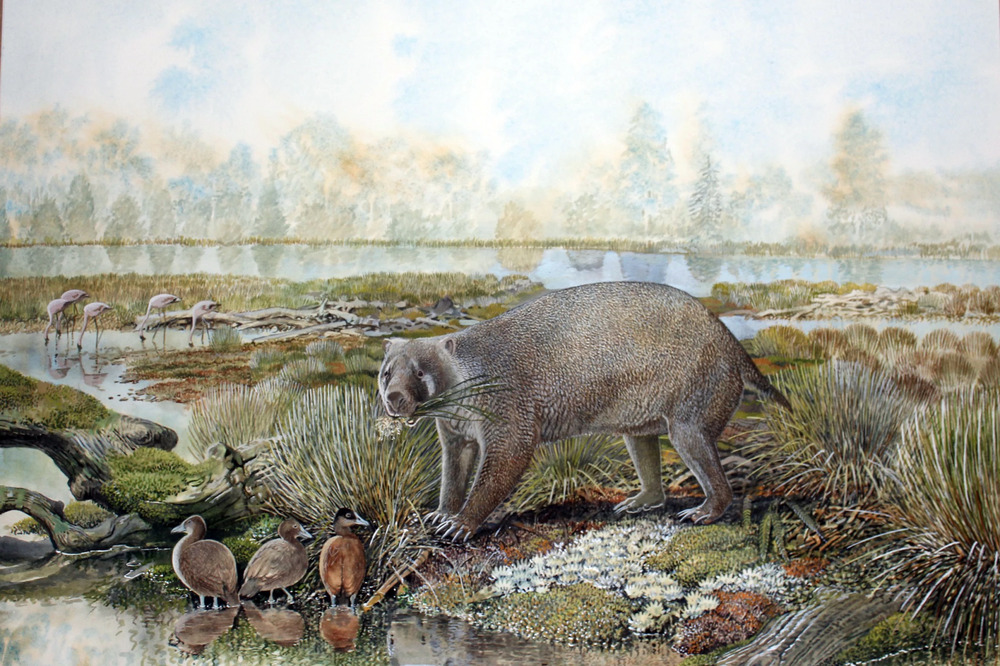PermeateFree said:
A new analysis of fossilized bones, unearthed 47 years ago in Australia, indicate that they’re from a previously unknown giant prehistoric relative of the wombat. It’s so different from other marsupials, however, that it’s been placed in a family all of its own.
Said to be about the size of a modern black bear and weighing around 150 kg (331 lb), the creature has been named Mukupirna nambensis – that means “big bones” in the Dieri and Malyangapa Aboriginal languages. It lived during the Oligocene epoch, approximately 25 million years ago, and is the sole member of the just-created Mukupirnidae family.
A partial skull and most of a skeleton were initially discovered in 1973, in the clay bed of Lake Pinpa, which is a dry salt lake east of the Flinders Range in South Australia.
Analysis of Mukupirna nambensis’ teeth suggest that despite its imposing size, it likely just fed on plants. And while its powerful front legs indicate that it was quite a good digger, it probably confined its digging to scratching for food such as roots and tubers – by contrast, modern wombats dig themselves burrows in the ground.

Mukupirna nambensis was over four times the size of a modern wombat
https://newatlas.com/biology/mukupirna-nambensis-prehistoric-wombat/
More at https://newsroom.unsw.edu.au/news/science-tech/new-extinct-family-giant-wombat-relatives-discovered-australian-desert
> UNSW Science’s Professor Mike Archer, a co-author on the paper
:-)
Archer is the one who gave us gems like montypythonoides, weirdodonta, thingodonta, the VD bandicoot, “killer kangaroos and demon ducks”, “outer site”.
> found the skeleton in 1973 in the clay floor of Lake Pinpa – a remote, dry salt lake east of the Flinders Ranges in South Australia. It was an extremely serendipitous discovery because in most years the surface of this dry lake is covered by sands blown or washed in from the surrounding hills. But because of rare environmental conditions prior to our arrival that year, the fossil-rich clay deposits were fully exposed to view. And this unexpected view was breathtaking.
> On the surface, and just below we found skulls, teeth, bones and in some cases, articulated skeletons of many new and exotic kinds of mammals. As well, there were the teeth of extinct lungfish, skeletons of bony fish and the bones of many kinds of water birds including flamingos and ducks. These animals ranged from tiny carnivorous marsupials about the size of a mouse right up to Mukupirna which was similar in size to a living black bear. It was an amazingly rich fossil deposit full of extinct animals that we’d never seen before.
> We found it by probing the dry flat surface of the Lake with a thin metal pole, like acupuncturing the skin of Mother Earth. We only excavated downwards into the clay if the pole contacted something hard below the surface – and in this case it turned out to be the articulated skeleton … Mukupirna is one of the best-preserved marsupials to have emerged from late Oligocene Australia (about 25 million years ago).
> how body size has evolved in vombatiform marsupials – the taxonomic group that includes Mukupirna, wombats, koalas and their fossil relatives – and showed that body weights of 100 kg or more evolved at least six times over the last 25 million years. The largest known vombatiform marsupial was the relatively recent Diprotodon, which weighed over 2 tonnes and survived until at least 50,000 years ago.
Technical article at https://www.nature.com/articles/s41598-020-66425-8
